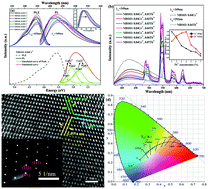Photo-/cathodoluminescence and energy transfer properties of novel Ce3+ singly doped and Ce3+/Tb3+ codoped NaBaScSi2O7 phosphors
Abstract
A series of novel Ce3+ singly doped and Ce3+/Tb3+ codoped color-tunable NaBaScSi2O7 phosphors were synthesized via the solid state method. The morphology, UV-vis reflectance, photoluminescence emission and excitation spectra, the lifetime and the thermal quenching properties were investigated in detail. NaBaScSi2O7:Ce3+ phosphors showed intense blue emission at about 425 nm, corresponding to the transitions from the lowest 5d excited state to the 2F5/2 and 2F7/2 spin orbit 4f ground states of Ce3+ ions, under optimal excitation of 349 nm. Under excitation of Ce3+ ions at 349 nm, the emission spectra of NaBaScSi2O7:Ce3+,Tb3+ phosphors consisted of a blue emission band of Ce3+ ions at 425 nm and a series of strong green emission lines at 488, 542, 582, and 625 nm due to the 5D4 → 7FJ (J = 6, 5, 4, and 3) characteristic transitions of Tb3+ ions. A possible energy transfer mechanism was proposed and ascribed to the dipole–dipole interaction on the basis of the experimental results and analysis. In addition, the cathodoluminescence properties of NaBaScSi2O7:Ce3+,Tb3+ were also studied in detail. The current results indicate that NaBaScSi2O7:Ce3+,Tb3+ can serve as a potential phosphor for application in UV-WLEDs and FEDs.


 Please wait while we load your content...
Please wait while we load your content...